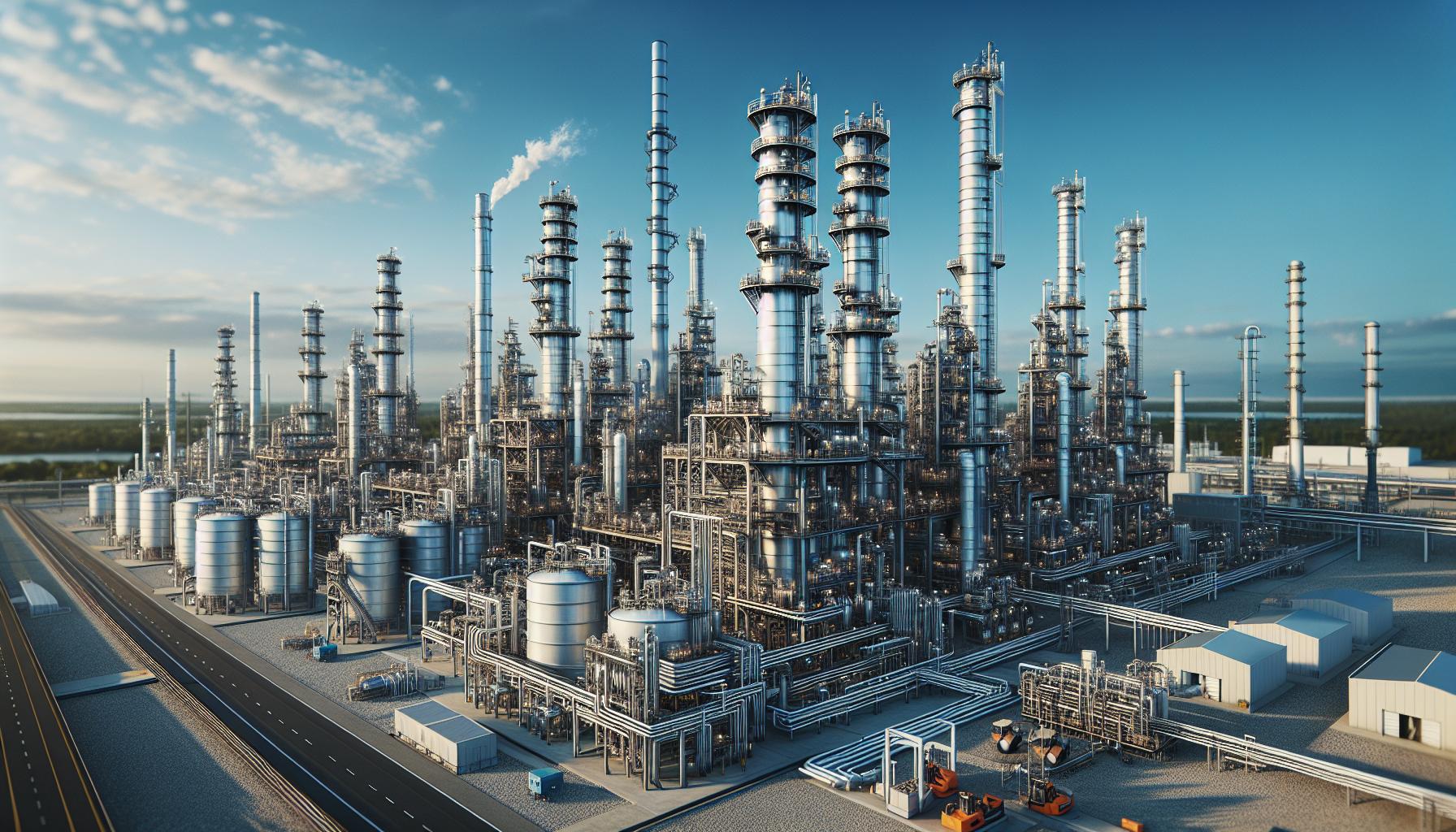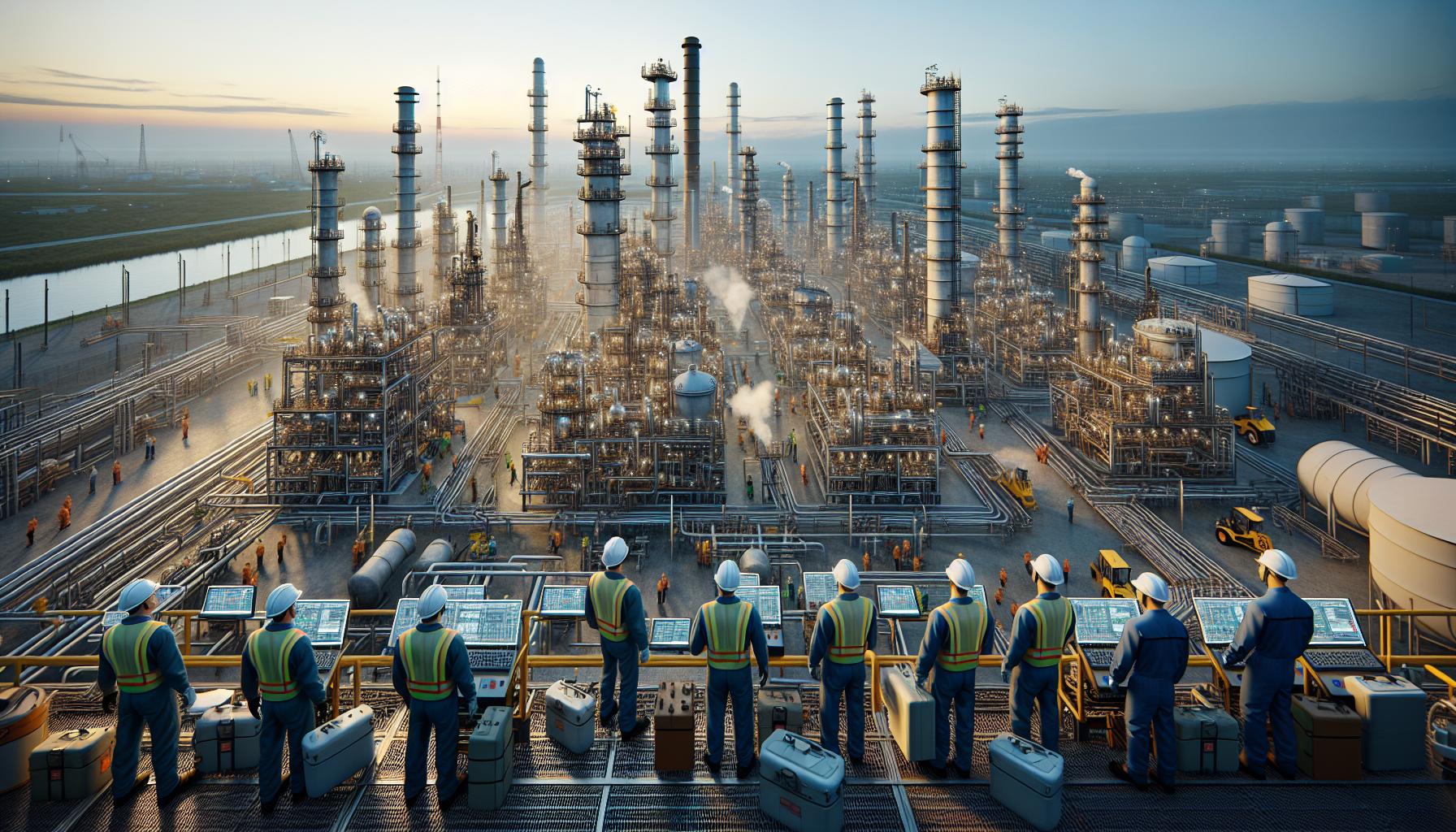Oil refining and marketing form the backbone of the global energy industry, transforming crude oil into valuable petroleum products that power modern life. From gasoline and diesel fuel to petrochemicals and lubricants, these refined products play a crucial role in transportation, manufacturing, and countless everyday applications.
The journey from oil well to consumer involves complex processes and sophisticated marketing strategies. Refineries use cutting-edge technology to break down crude oil into its components through distillation, cracking, and treatment processes. Meanwhile, marketing teams develop strategic approaches to distribute these products efficiently across global markets, ensuring steady supply chains and competitive pricing for consumers.
Understanding the Oil Refining Process
Oil refining transforms crude oil into usable petroleum products through a series of chemical processes and treatments. The refining process separates crude oil components based on their molecular weights and boiling points.
Crude Oil Processing Steps
- Atmospheric Distillation
- Heats crude oil to 350°C in distillation towers
- Separates components by boiling point differences
- Collects various fractions at different tower levels
- Vacuum Distillation
- Processes heavy residue from atmospheric distillation
- Operates under reduced pressure at 200°C
- Extracts additional heavy fuel oils lubricants
- Catalytic Cracking
- Breaks long hydrocarbon chains into shorter molecules
- Uses catalysts zeolites aluminum silicates
- Converts heavy oils into lighter products
- Hydrocracking
- Combines hydrogen with heavy oil molecules
- Operates at high pressure (1,500-3,000 psi)
- Produces high-quality diesel jet fuel
| Product Category | Temperature Range (°C) | Primary Uses |
|---|---|---|
| Light Distillates | 20-150 | Gasoline, Naphtha |
| Middle Distillates | 150-275 | Kerosene, Diesel |
| Heavy Distillates | 275-400 | Fuel Oil, Lubricants |
| Residuals | >400 | Asphalt, Waxes |
- Transportation Fuels
- Gasoline (87-93 octane ratings)
- Diesel fuel (40-55 cetane number)
- Aviation fuel (100+ octane rating)
- Industrial Products
- Lubricating oils (5-50 viscosity grades)
- Industrial solvents (99% purity)
- Petrochemical feedstocks
- Consumer Products
- Heating oil (140,000 BTU/gallon)
- Propane (91,500 BTU/gallon)
- Asphalt materials
Refinery Operations and Technology

Modern oil refineries employ sophisticated equipment and advanced control systems to process crude oil efficiently. Advanced automation technology integrates seamlessly with mechanical systems to optimize production output quality safety standards.
Major Equipment and Systems
Refineries operate with specialized equipment designed for specific processing functions:
- Crude Distillation Units (CDUs) process 100,000-250,000 barrels per day through thermal separation columns
- Fluid Catalytic Crackers (FCCs) convert heavy hydrocarbons into lighter products using specialized catalysts at 900-1000°F
- Hydrotreaters remove sulfur impurities through hydrogen reaction chambers operating at 600-700°F
- Reforming Units enhance gasoline octane ratings using platinum-based catalysts
- Heat Exchangers recover thermal energy between process streams with 85-95% efficiency
- Control Systems monitor 50,000+ data points through distributed control systems (DCS)
| Equipment Type | Typical Capacity | Operating Temperature |
|---|---|---|
| CDU | 250,000 bbl/day | 650-750°F |
| FCC | 80,000 bbl/day | 900-1000°F |
| Hydrotreater | 60,000 bbl/day | 600-700°F |
- Emergency Shutdown Systems activate within 3 seconds of detecting critical process deviations
- Emissions Monitoring tracks 15+ air quality parameters through continuous monitoring systems
- Wastewater Treatment processes 500,000-1,000,000 gallons daily through multiple purification stages
- Vapor Recovery Units capture 98% of volatile organic compounds from storage tanks
- Fire Protection includes automated suppression systems covering 100% of critical process areas
- Gas Detection networks utilize 1,000+ sensors monitoring for hydrocarbon leaks
- Flare Systems safely combust excess gases at heights of 200-300 feet
Economics of Oil Refining
Oil refining economics revolve around complex cost structures and market dynamics that determine profitability. The financial performance of refineries depends on the relationship between crude oil costs and refined product prices, known as the crack spread.
Operating Costs and Margins
Refinery operating costs include fixed expenses like labor, maintenance and utilities alongside variable costs such as crude oil and chemicals. Labor costs represent 20-30% of total operating expenses, while energy consumption accounts for 40-50% of operational costs. The refining margin (crack spread) typically ranges from $5-15 per barrel, varying by region and market conditions.
| Cost Component | Percentage of Operating Costs |
|---|---|
| Energy | 40-50% |
| Labor | 20-30% |
| Maintenance | 15-20% |
| Chemicals | 5-10% |
| Other | 5-10% |
- Crude oil prices fluctuate based on global supply demand dynamics
- Seasonal demand patterns affect gasoline diesel pricing cycles
- Regional supply logistics impact transportation fuel costs
- Environmental regulations create price differentials between markets
- Refinery capacity utilization rates influence product availability
- Currency exchange rates affect international trade economics
| Price Factor | Impact on Margins |
|---|---|
| Summer Demand | +$2-4/barrel |
| Winter Demand | +$3-5/barrel |
| Regulations | -$1-3/barrel |
| Location | ±$2-4/barrel |
Oil Marketing Strategies
Oil marketing strategies encompass distribution networks, branding initiatives, and retail operations that connect refined petroleum products with end consumers. These strategies integrate market analysis, pricing mechanisms, and customer relationship management to optimize sales and maintain competitive advantage.
Distribution Channels
Oil distribution networks operate through multiple tiers of intermediaries to ensure efficient product delivery. Primary distribution channels include:
- Terminal Networks: Strategic storage facilities located near major consumption centers
- Pipeline Systems: Underground networks spanning thousands of miles for cost-effective bulk transport
- Transportation Fleets: Dedicated tanker trucks, rail cars, and marine vessels for last-mile delivery
- Wholesale Partners: Licensed distributors managing regional product allocation
- Commercial Accounts: Direct supply relationships with industrial customers, airlines, and utility companies
| Distribution Channel | Market Share | Average Lead Time |
|---|---|---|
| Terminal Networks | 35% | 24-48 hours |
| Pipeline Systems | 45% | 3-5 days |
| Transportation Fleets | 15% | 12-24 hours |
| Direct Sales | 5% | 1-2 days |
- Station Design: Consistent architectural elements, lighting, and signage across locations
- Product Differentiation: Premium fuel formulations with proprietary additives
- Loyalty Programs: Points-based rewards systems tracking customer purchase patterns
- Digital Integration: Mobile payment options and real-time price updates
- Convenience Stores: Additional revenue streams through non-fuel merchandise sales
| Retail Component | Revenue Impact | Customer Retention Rate |
|---|---|---|
| Premium Fuels | +15% margin | 68% |
| Loyalty Programs | +8% sales | 73% |
| Convenience Stores | +25% revenue | 82% |
| Digital Solutions | +12% efficiency | 77% |
Industry Challenges and Opportunities
The oil refining and marketing sector faces dynamic challenges while capitalizing on emerging opportunities. Environmental regulations transform operational requirements as market competition shapes industry strategies.
Environmental Regulations
Environmental regulations create significant operational impacts for refineries through emissions standards compliance costs. The Environmental Protection Agency’s Tier 3 standards require sulfur content in gasoline below 10 parts per million, demanding $2-3 billion in refinery upgrades. Key regulatory requirements include:
- Carbon emissions reduction targets of 45% by 2030 compared to 2005 levels
- Installation of Vapor Recovery Units (VRUs) with 98% capture efficiency
- Wastewater treatment systems meeting EPA’s ELG standards
- Benzene monitoring systems with real-time detection capabilities
- LOW-NOx burners reducing nitrogen oxide emissions by 40%
- Product specifications meeting regional fuel standards
- Transportation costs averaging $2-4 per barrel
- Storage capacity optimization at 85% utilization rates
- Digital technology integration reducing operational costs by 15%
- Strategic partnerships with retail networks expanding market reach
| Competition Metric | Industry Average |
|---|---|
| Refining Margin | $8.50/barrel |
| Operating Cost | $4.20/barrel |
| Market Share Required for Profitability | 12% |
| Capacity Utilization | 82% |
| Distribution Network Coverage | 65% |
Future Trends in Refining
The oil refining industry faces significant technological transformation driven by environmental regulations and digital innovation. These changes reshape operational efficiency and product specifications across global refineries.
Clean Fuel Technologies
Advanced desulfurization processes reduce sulfur content in fuels to less than 10 parts per million. Refineries implement renewable fuel integration systems to blend biofuels with conventional petroleum products at ratios of 5-20%. Key clean fuel innovations include:
- Selective catalytic hydrogenation units that remove 99.9% of impurities
- Biomass co-processing facilities converting organic waste into renewable diesel
- Carbon capture systems reducing emissions by 25-40% per facility
- Low-carbon hydrogen production units generating 50,000 kg/day for fuel upgrading
| Clean Fuel Technology | Emission Reduction | Implementation Cost |
|---|---|---|
| Hydrodesulfurization | 95-98% sulfur removal | $200-300M |
| Biomass Processing | 50-70% carbon reduction | $150-250M |
| Carbon Capture | 25-40% CO2 reduction | $400-600M |
- Real-time process optimization platforms reducing energy consumption by 15%
- Predictive maintenance systems decreasing downtime by 30%
- Digital twin simulations modeling plant operations with 95% accuracy
- IoT sensor networks monitoring 10,000+ data points per minute
| Digital Solution | Efficiency Gain | ROI Timeline |
|---|---|---|
| AI Optimization | 10-15% energy savings | 18-24 months |
| Predictive Analytics | 25-30% maintenance reduction | 12-18 months |
| Digital Twins | 20-25% process improvement | 24-36 months |
Conclusion
Oil refining and marketing stand as critical pillars of the global energy industry shaping how crude oil transforms into essential products that power modern life. The intricate balance of sophisticated refining processes advanced technology and strategic marketing continues to evolve with changing market demands and environmental standards.
The industry’s future lies in embracing cleaner technologies digital innovations and sustainable practices while maintaining operational efficiency. As refineries adapt to stricter regulations and shifting consumer preferences they’ll need to focus on both technological advancement and market adaptability to remain competitive in this dynamic sector.
This transformation offers both challenges and opportunities as the industry moves toward a more sustainable and technologically advanced future while maintaining its vital role in the global economy.

